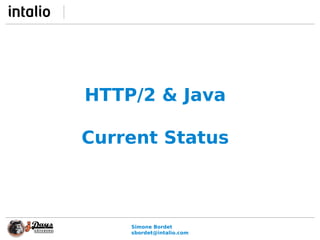HTTP 2.0 & Java: Current Status", Part 1, jDays 2015 Speaker: "Simone Bordet
- 1. Simone Bordet sbordet@intalio.com HTTP/2 & Java Current Status
- 2. Simone Bordet sbordet@intalio.com Who Am I ’éĪSimone Bordet ’éĪ sbordet@intalio.com - @simonebordet ’éĪLead Architect at Intalio/Webtide ’éĪ Jetty's HTTP/2, SPDY and HTTP client maintainer ’éĪOpen Source Contributor ’éĪ Jetty, CometD, MX4J, Foxtrot, LiveTribe, JBoss, Larex ’éĪCometD project leader ’éĪ Web messaging framework ’éĪJVM tuning expert
- 4. Simone Bordet sbordet@intalio.com HTTP/2: Why ’éĪhttp://w3c.org ~ 1996 ’éĪ 1 HTML file, 600 bytes
- 5. Simone Bordet sbordet@intalio.com HTTP/2: Why ’éĪhttp://w3c.org ~ 2015 ’éĪ 41 resources, 366 KiB ~ 1 HTML, 4 CSS, 2 JS, 34 images
- 6. Simone Bordet sbordet@intalio.com HTTP/2: Why ’éĪhttp://cnn.com ~ 2015 ’éĪ 95 resources, 6.7 MiB ~ 3 HTML, 4 CSS, 30 JS, 58 imgs
- 7. Simone Bordet sbordet@intalio.com HTTP/2: Why ’éĪThe Web EXPLODED ! ’éĪHTTP 1.1 is an old protocol ’éĪ Extremely inefficient ’éĪ No multiplexing, no resource correlation ’éĪWeb developers hacking around limitations ’éĪ Domain sharding, resource inlining, image spriting, etc. ’éĪBrowser vendors want to make browsers FAST ’éĪ Break HTTP 1.1 recommendations
- 8. Simone Bordet sbordet@intalio.com HTTP/2: Why ’éĪServers want to BE REALLY FAST
- 9. Simone Bordet sbordet@intalio.com HTTP/2: Why Better HTTP means MORE MONEY
- 11. Simone Bordet sbordet@intalio.com HTTP/2: How ’éĪHTTP/2: Binary protocol ’éĪ Based on the SPDY protocol (Google's experiment) ’éĪ Efficient to parse and generate ’éĪ Based on frames HEADERS HEADERS DATA DATA DATA
- 12. Simone Bordet sbordet@intalio.com HTTP/2: How ’éĪHTTP/2: TLS everywhere ’éĪ Usage of TLS (SSL) is a MUST for browsers ’éĪ Very strict subset of strong ciphers ’éĪTransparent proxy problem ’éĪ Caching proxies don't work anymore ’éĪ Big problem for certain countries ’éĪServer-to-Server communication may be in clear ’éĪ Not every server supports clear-text HTTP/2
- 13. Simone Bordet sbordet@intalio.com ’éĪHTTP/2: Multiplexed ’éĪ No more domain sharding and spriting hacks needed HEADERS HEADERS HEADERS HEADERS HEADERS HEADERS DATA DATA
- 14. Simone Bordet sbordet@intalio.com HTTP/2: How ’éĪHTTP/2: HTTP Headers compression ’éĪ Optimized usage of network ’éĪ Using Huffman coding ’éĪ ~600B ŌåÆ ~90B => 85% saved on headers ’éĪHTTP/2: Request Prioritazion ’éĪ Resources may have a priority ’éĪ Clients may even re-prioritize ’éĪHTTP/2: Push of correlated HTTP resources ’éĪ Less roundtrips to get all resources ’éĪ Huge benefits in page rendering
- 17. Simone Bordet sbordet@intalio.com HTTP/2: When ’éĪHTTP/2 Specification under IESG editing ’éĪ It's basically a standard, unlikely to change further ’éĪBrowsers already implement HTTP/2 (TLS only) ’éĪ Firefox 34 ’éĪ Chrome 38 ’éĪ Internet Explorer 11 ’éĪIt's already there ’éĪ Twitter, Google, major websites ’éĪ Our own https://webtide.com
- 19. Simone Bordet sbordet@intalio.com HTTP/2: Who ’éĪcURL & Wireshark ’éĪ Unix tools support for HTTP/2 ’éĪ35+ Implementations ’éĪ https://github.com/http2/http2-spec/wiki/Implementations ’éĪJava, C, C++, Go, NodeJS, Erlang, Haskell, etc.
- 21. Simone Bordet sbordet@intalio.com HTTP/2: Java ’éĪNo changes required to your WARs ’éĪExisting web applications work out-of-the-box ’éĪPush functionalities provided by servers and frameworks ’éĪPossible action: remove old HTTP/1.1 hacks
- 22. Simone Bordet sbordet@intalio.com HTTP/2: Java ’éĪHTTP/2 compliant servers require JDK 8 ’éĪ Due to the fact that HTTP/2 requires strong ciphers ’éĪ Server-to-Server clear text may run on JDK 7 ’éĪServlet 4.0 will support HTTP/2 ’éĪ Backwards compatible ’éĪ Few new API changes ’éĪ New HTTP Push API
- 23. Simone Bordet sbordet@intalio.com HTTP/2: Java ’éĪJEP 110 (http://openjdk.java.net/jeps/110) ’éĪ HTTP/2 Client proposal for JDK 9 ’éĪ HTTP/2 Client API proposed: ’éĪ http://cr.openjdk.java.net/~michaelm/httpclient/01/ ’éĪIn the Java World: ’éĪ Jetty (server + client) ŌĆō Live @ https://webtide.com ’éĪ Netty ’éĪ Undertow ’éĪ OkHttp (Android)
- 24. Simone Bordet sbordet@intalio.com HTTP/2: Java ’éĪJetty provides a pure HTTP/2 client ’éĪJetty's HttpClient provides a HTTP/2 transport ’éĪ Applications use HttpClient high-level API // Standard HTTP/1.1 client new HttpClient(); // HTTP/2 transport client new HttpClient(new HttpClientTransportOverHTTP2());
- 27. Simone Bordet sbordet@intalio.com HTTP/2: Conclusions ’éĪNo changes for Web Developers ’éĪ Servlet API backward compatible ’éĪ Frameworks (JSF) will be able to leverage HTTP Push ’éĪ No more domain sharding / spriting hacks needed ’éĪ JDK 9 possibly updated to support HTTP 2.0 ’éĪSome change for Deployers (devops / sysops) ’éĪ TLS everywhere ’éĪ Upgrade your Servlet Container ’éĪ Jetty 9.3 ’éĪ Upgrade network infrastructure (e.g. load balancers)
- 28. Simone Bordet sbordet@intalio.com HTTP/2: Conclusions HTTP/2 Makes You Money Upgrade To Jetty :)




























